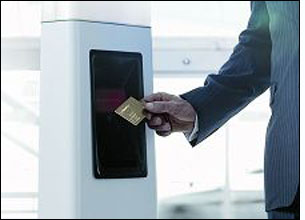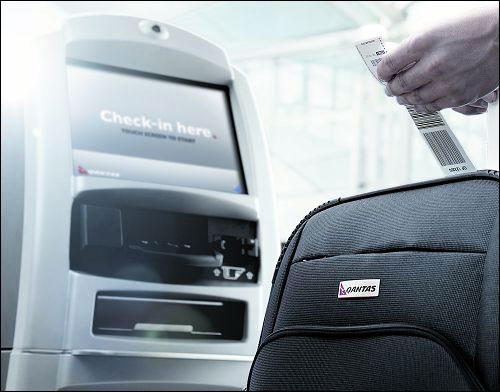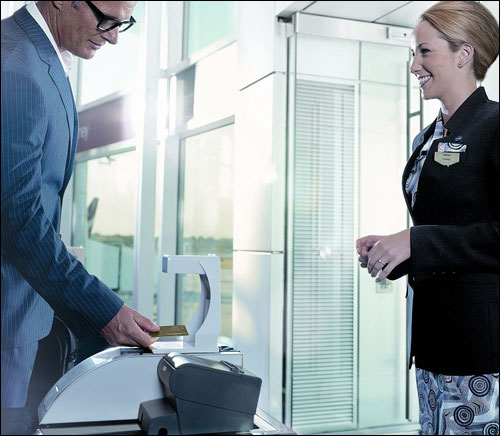On Wednesday this week, Australian airline Qantas plans to roll out its Next Generation check-in system, including the introduction of radio frequency identification for use in check-in, boarding and baggage tracking.
As part of the first phase of the deployment at Perth Airport, some 100,000 Qantas platinum, gold, silver and bronze frequent flyers will be provided with new loyalty cards with built-in passive high frequency (HF) RFID inlays that the airline refers to as “intelligent Q chips.” According to the airline, customers will be able to use their new loyalty cards to check in themselves and their luggage. The cards will also act as permanent boarding passes, replacing eligible patrons’ existing frequent-flyer cards.

Qantas reports that passengers will be able to check in within five seconds of swiping their card over an RFID reader (known as a Q Card Reader) and receive confirmation to their mobile phone within 15 seconds. This will replace more time-consuming methods, such as online check-in, airport kiosks and check-in desks, all of which require the manual inputting of travel information.
The Next Generation system, originally announced in November 2009, is the culmination of two years’ work with such vendors as IBM, Unisys, Fujitsu, New Media Innovations, Amadeus, Telstra and Satyam, and is expected to speed up check-in and reduce airport congestion.
Delays and long queues at airports were a “point of pain” for passengers, according to a Qantas spokesperson. But replacing previous check-in methods that require the manual inputting of information with RFID is expected to improve speed, customer service and ease in passing through the airport, all of which are vital to improving travelers’ overall experience.

If, upon arriving at the airport, Qantas’ frequent flyers have not already checked in either online or on their mobile phone, they will be able to so simply by swiping their card over the RFID reader. Within five seconds, a passenger will be automatically checked in, and within 15 seconds, confirmation will be sent to that individual’s mobile phone. Frequent flyers will also be able to scan their cards’ Q chip at a bag check-in kiosk, where they can weigh their baggage, receive printed luggage tags they can attach to their bags, pay for excess baggage or modify booking information.The RFID readers and tags are provided by STMicroelectronics, Tagsys, Motorola, SICK and Gemalto.
Starting in November 2010, passengers at Sydney Airport will be able to check in their luggage at new automated bag-drop points, using their RFID-enabled loyalty card. The bags will be weighed using pressure pads, and measured with lasers to determine their dimensions. Each passenger will then be issued a durable, reusable Q Bag Tag containing a passive ultrahigh-frequency (UHF) EPC Gen 2 RFID inlay. Information, including that individual’s name, destination and bag-forwarding instructions, will be encoded to the inlays. The Q Bag Tags will replace the traditional printed baggage tags used by Qantas, and the information will be transmitted to the airline’s database, where it will then be synced up with data from the loyalty card. The Q Bag Tag’s RFID inlay will enable Qantas’ workers to utilize a handheld reader trace to locate a bag in the hold of an aircraft, thus making it faster for the company to find a specific piece of luggage in the event that it needs to be removed from the aircraft prior to take-off.

Qantas reports that it has contingency plans in place to prevent system crashes from delaying flights if the automated check-in system were to fail. The airline’s check-in attendants, Qantas explains, would print manual documents, performing manual check-in and bag-handling procedures until the system was restored.
The Next Generation check-in system was launched to provide an enhanced travel experience and improve customers’ journey, according to the Qantas spokesperson, and was developed over a span of two years. The RFID inlays used for the new loyalty cards and the Q Bag Tags comply with all standards required by Australian government and International Air Transport Association (IATA) regulations.
“RFID was identified early on in the process as a key enabler in our vision, and was subsequently trialed and developed,” the spokesperson states. “When selecting vendors, Qantas looked beyond the physical RFID device and evaluated vendors based on their ability to provide end-to-end solutions that met Qantas’ specific requirements. Qantas conducted a number of trials to ensure the frequent-flyer card, featuring the intelligent Q chip, was ready for use at the beginning of the Perth trial. Testing identified the benefit of speed and ease of use. Each trial provided good learning, which has been applied to the final product.”
Qantas expects the rollout of its Next Generation check-in system to be completed at all major Australian cities by the second half of 2011. Construction and training are continuing at Sydney Airport ahead of its planned roll out later this year, with Melbourne, Brisbane, Adelaide and Canberra to follow in 2011.

